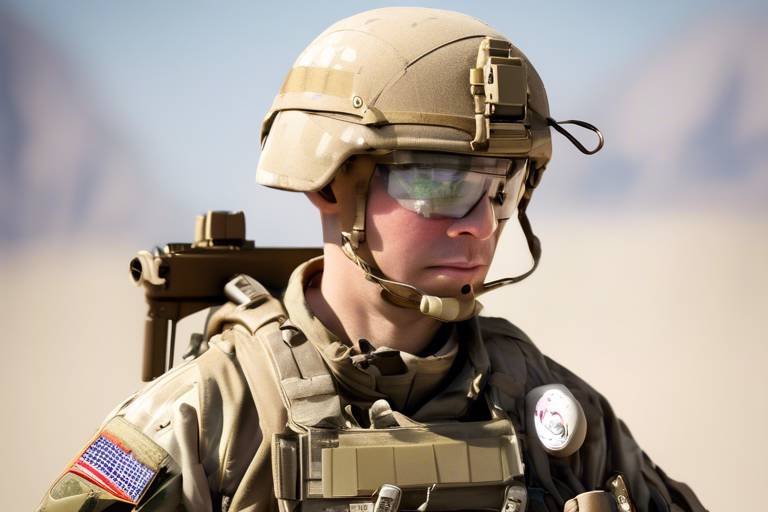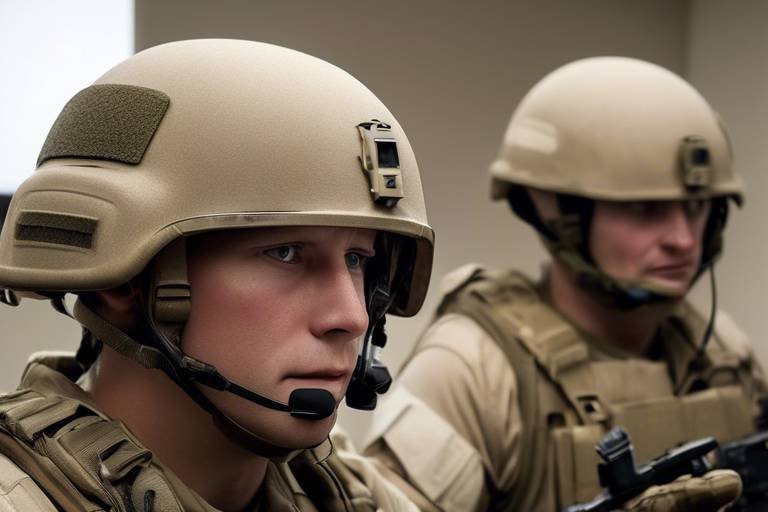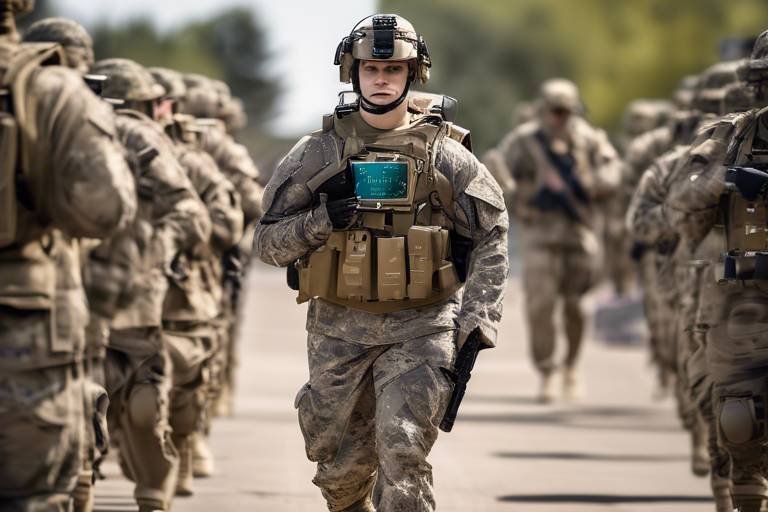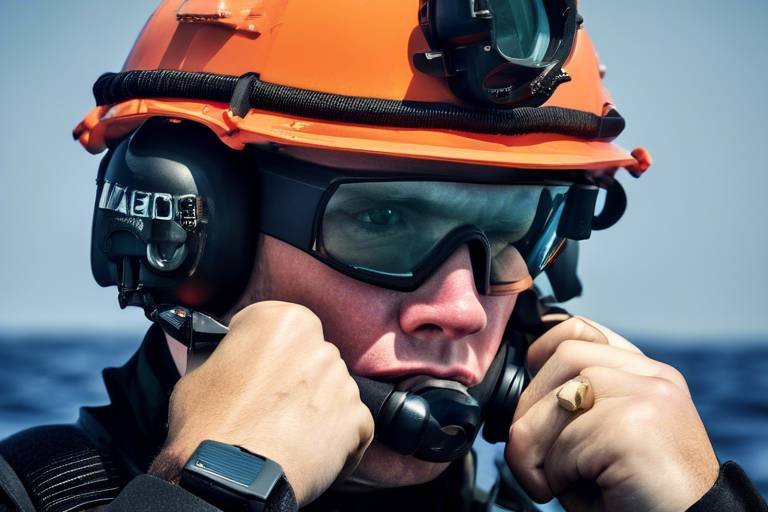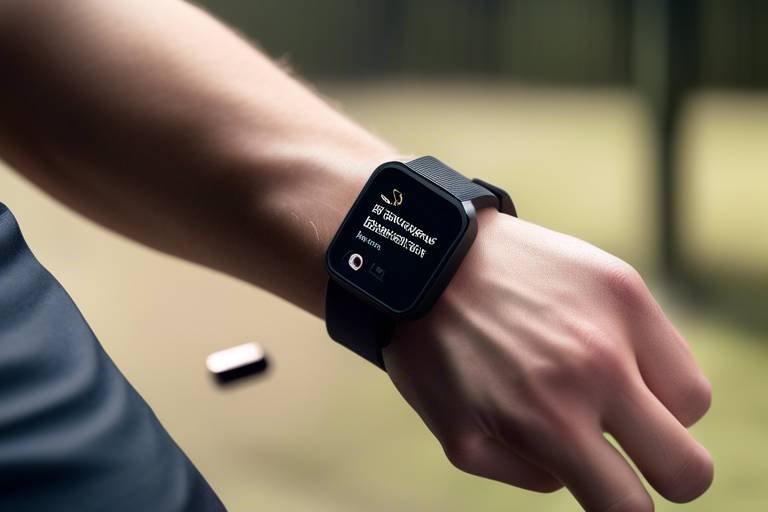How Wearable Tech Improves Post-Deployment Transition
This article explores the role of wearable technology in aiding service members' transition to civilian life, focusing on mental health, physical fitness, and community support. The journey from military to civilian life can be a challenging one, filled with uncertainties and adjustments. However, the advent of wearable technology has opened up new avenues for support, making this transition smoother and more manageable. Imagine having a personal coach on your wrist, ready to help you navigate the complexities of post-deployment life. That's precisely what these devices offer, blending technology with personal well-being.
Wearable devices can monitor stress levels and provide real-time feedback, helping veterans manage anxiety and depression during their transition. Think of it as having a mental health ally that tracks your emotional state and alerts you when things might be getting overwhelming. By using sensors to gather data on heart rate variability and other physiological markers, these devices can give users insights into their mental well-being. For instance, if your heart rate spikes during a stressful moment, your device might suggest a breathing exercise or a short meditation session. This proactive approach can make a significant difference in managing mental health.
Fitness trackers encourage physical activity, which is crucial for veterans' physical health and overall well-being post-deployment. Engaging in regular exercise not only boosts physical fitness but also releases endorphins, which are known to improve mood. When veterans wear devices that track their activity levels, they can easily see their progress and stay motivated. Imagine setting a goal to walk 10,000 steps a day and watching your progress in real-time. It’s like having a personal cheerleader, urging you to keep moving and stay active.
Wearable devices allow users to set fitness goals, track progress, and stay motivated, fostering a healthier lifestyle. By breaking down larger goals into smaller, manageable milestones, veterans can celebrate their achievements along the way. For example, a simple goal like "walk 5,000 steps today" can be a stepping stone toward larger fitness objectives. This incremental approach helps maintain motivation and encourages consistency, which is vital for long-term success.
Establishing daily routines with the help of wearables can significantly improve a veteran's physical and mental health. Routines provide structure, which can be particularly beneficial during the transition phase. With reminders for workouts, hydration, and even mindfulness practices, wearables can help veterans develop habits that promote overall well-being. Think of it as having a personal assistant that not only keeps you organized but also nudges you toward healthier choices.
Participating in fitness challenges through wearable tech can help veterans connect with others, promoting a sense of community. Many wearable devices come with social features that allow users to join groups, participate in challenges, and share their achievements. This interaction fosters camaraderie and support among veterans who might be experiencing similar challenges. It’s like being part of a team again, where everyone is cheering each other on, making the journey less isolating.
Wearables can facilitate social interactions and provide platforms for veterans to share experiences, reducing feelings of isolation. In a world where technology often disconnects us, these devices can actually bring people together. Whether it’s through group fitness challenges or virtual meet-ups, veterans can find a supportive network that understands their unique experiences. This sense of belonging is crucial for mental health and overall happiness.
Wearable technology provides valuable data that can inform healthcare providers about veterans’ needs, improving support systems. By collecting and analyzing data on physical activity, sleep patterns, and stress levels, healthcare professionals can gain insights into the well-being of veterans. This data-driven approach allows for more personalized care, ensuring that veterans receive the support they need when they need it most.
Analyzing data from wearables can lead to tailored health recommendations for veterans, enhancing their transition experience. Imagine receiving customized advice based on your daily activity levels and mental health metrics. This level of personalization can empower veterans to take charge of their health, making informed decisions that align with their unique needs.
Wearable tech can streamline access to mental health resources, ensuring veterans receive timely support during their transition. With just a few taps, veterans can connect with healthcare providers, access therapy sessions, or find local support groups. This ease of access is crucial in moments when they might feel overwhelmed or in need of immediate assistance.
- What types of wearable tech are best for veterans? Fitness trackers, smartwatches, and mental health monitoring devices are popular choices.
- How can wearables help with mental health? They provide real-time feedback on stress levels and can suggest coping strategies.
- Are there community features in wearable devices? Yes, many devices offer social features that allow users to connect with others.
- Can wearables improve physical fitness? Absolutely! They track activity levels, set goals, and encourage regular exercise.
The Role of Wearable Tech in Mental Health
In today's fast-paced world, mental health has become a crucial topic, especially for veterans transitioning back to civilian life. The good news? Wearable technology is stepping up to the plate, providing innovative solutions to help service members manage their mental well-being. These devices, often worn on the wrist or as smart clothing, can monitor various physiological metrics, giving users real-time insights into their mental state. Imagine having a personal assistant that not only tracks your steps but also keeps an eye on your stress levels!
One of the most significant advantages of these wearables is their ability to monitor stress levels. By analyzing heart rate variability and other biometric data, these devices can detect when a user is feeling anxious or overwhelmed. This real-time feedback empowers veterans to take action before their stress spirals out of control. For instance, if a veteran receives a notification indicating high stress levels, they could take a moment to practice deep breathing or engage in a quick walk—simple yet effective strategies to regain calmness.
Moreover, wearables often come equipped with features like guided meditation and mindfulness exercises. By integrating these practices into their daily routine, veterans can cultivate a healthier mindset. Picture this: instead of scrolling through social media during a break, a veteran might opt for a short meditation session suggested by their wearable. This shift not only enhances their mental health but also fosters a sense of self-awareness and emotional resilience.
Another exciting aspect of wearable tech is its ability to facilitate connection. Many devices allow users to join communities where they can share their experiences and support one another. This is particularly important for veterans who may feel isolated after deployment. By participating in forums or social challenges through their devices, they can connect with others who understand their journey. It's like having a support group right on your wrist!
In summary, wearable technology plays a pivotal role in supporting the mental health of veterans during their transition to civilian life. By providing real-time feedback, promoting mindfulness, and fostering connections, these devices can significantly enhance the well-being of those who have served. With the right tools at their disposal, veterans can navigate their new lives with greater ease and confidence.
- How do wearables monitor mental health? Wearables track physiological metrics such as heart rate and sleep patterns, providing insights into stress levels and overall mental well-being.
- Can wearables help with anxiety management? Yes, many devices offer features like guided meditation and stress alerts, helping users manage anxiety proactively.
- Is there a community aspect to wearable tech? Absolutely! Many wearables have social features that allow users to connect with others, share experiences, and participate in challenges.
In today's fast-paced world, wearable technology has emerged as a game-changer, especially for veterans transitioning to civilian life. These devices, ranging from smartwatches to fitness bands, are not just trendy gadgets; they serve a significant purpose in enhancing physical fitness. Imagine strapping on a device that not only tracks your steps but also motivates you to move more and live healthier. That's the magic of wearables!
One of the most compelling aspects of fitness trackers is their ability to encourage physical activity. After deployment, many veterans face challenges in maintaining an active lifestyle. Wearable tech can play a pivotal role in overcoming these hurdles by providing real-time feedback on activity levels. This feedback can be a powerful motivator. For instance, seeing your step count increase or hitting your daily exercise goals can create a sense of accomplishment. It's like having a personal trainer on your wrist!
Moreover, wearables allow users to track progress and set achievable fitness goals. Whether it's running a certain distance, lifting specific weights, or simply taking more steps each day, these devices help veterans stay focused and committed to their fitness journeys. The process of goal-setting can be incredibly empowering. It transforms fitness from a daunting task into a series of manageable challenges. And who doesn't love a good challenge?
With wearables, tracking progress is a breeze. Many devices come equipped with apps that provide detailed insights into your physical activity. For example, you can view your weekly performance, monitor your heart rate, and even analyze your sleep patterns. This data can help veterans understand their bodies better and make informed decisions about their health. Setting goals becomes more than just a wish; it transforms into a structured plan. You can set short-term goals, like walking 10,000 steps a day, and long-term goals, such as training for a marathon. Each achievement is a step closer to a healthier lifestyle.
Establishing daily routines is crucial for veterans, especially during the transition period. Wearable technology can assist in building these routines by reminding users to stay active throughout the day. For example, many devices send notifications to encourage users to get up and move after prolonged periods of inactivity. This kind of gentle nudge can make a world of difference in maintaining a balanced lifestyle. Think of it as your friendly reminder to take a break from the couch and stretch those legs!
Another exciting feature of wearable technology is its ability to foster community engagement. Many fitness apps allow users to participate in challenges or join groups, creating a sense of camaraderie among veterans. Imagine competing in a step challenge with fellow veterans or sharing your workout achievements on social media. This not only promotes a sense of community but also combats feelings of isolation that many veterans experience. Engaging in fitness challenges can lead to new friendships and support networks, making the transition to civilian life a little less daunting.
In addition to enhancing physical fitness, wearables can combat isolation by facilitating social interactions. Many devices come with built-in features that allow users to connect with friends and family. Sharing fitness milestones or participating in group workouts can create a supportive environment. This social aspect is vital for veterans who may feel disconnected after leaving the military. It's like having a virtual buddy system that keeps you accountable and encourages you to keep pushing forward.
In summary, wearable technology is not just about tracking steps; it's about transforming lives. By enhancing physical fitness, promoting community engagement, and providing the tools to set and achieve goals, wearables can significantly improve the post-deployment experience for veterans. So, if you’re a veteran looking to make a change, consider investing in a wearable device. It might just be the key to unlocking a healthier, happier you!
- What types of wearable devices are best for tracking fitness? Fitness trackers, smartwatches, and heart rate monitors are popular choices.
- Can wearables help with mental health? Yes, many devices track stress levels and provide insights that can aid in managing mental health.
- How do I choose the right wearable for me? Consider your fitness goals, budget, and the features that are most important to you.
- Are wearable devices accurate? While they provide valuable data, accuracy can vary between devices. It's essential to research and choose a reputable brand.
Tracking Progress and Setting Goals
When it comes to transitioning from military to civilian life, setting goals and tracking progress can feel like navigating a maze without a map. But guess what? Wearable technology is like that trusty GPS that guides you through those twists and turns. These devices are not just fancy gadgets; they are powerful tools that can help veterans establish clear objectives and monitor their journey every step of the way.
Imagine strapping on a fitness tracker that not only counts your steps but also tracks your heart rate, sleep patterns, and even stress levels. This real-time data is crucial for veterans who are working on their physical fitness and mental well-being. By having access to this information, users can set specific, measurable, achievable, relevant, and time-bound (SMART) goals. For instance, rather than saying, “I want to get fit,” a veteran might set a goal to “walk 10,000 steps a day for the next month.” This kind of clarity can make all the difference.
Moreover, wearables often come with mobile apps that allow users to visualize their progress. Think of it as having a personal cheerleader right on your wrist! These apps can provide insights into how far you've come and where you need to improve. For example, if a veteran's goal is to improve their running speed, the app can show them detailed statistics on their pace over time, encouraging them to push a little harder or adjust their training plan. This feedback loop can be incredibly motivating, especially when users can see tangible results from their efforts.
Additionally, many wearables offer community features that can foster a sense of camaraderie. Users can join challenges with friends or other veterans, creating a supportive environment where everyone is working towards their goals together. Imagine participating in a virtual 5K with fellow veterans, where you can share your progress, celebrate achievements, and even motivate each other when the going gets tough. This sense of community can be a game-changer, making the journey feel less isolating and more collaborative.
In summary, tracking progress and setting goals with wearable technology is not just about numbers; it's about creating a roadmap for success. These devices empower veterans to take charge of their health and well-being, offering insights that can lead to healthier lifestyles and improved mental health. So, whether it’s hitting that daily step count or achieving a personal best in a fitness challenge, wearables help pave the way for a fulfilling post-deployment life.
- What types of wearable devices are best for tracking fitness? Fitness trackers, smartwatches, and heart rate monitors are popular choices that offer various features for tracking physical activity.
- How can wearables help with mental health? Many wearables include stress monitoring and mindfulness features, helping users manage anxiety and improve their overall mental well-being.
- Can I connect with others through my wearable device? Yes! Many wearable devices have community features that allow you to join challenges and connect with other users for support.
- Are there specific wearables designed for veterans? Some companies offer wearables tailored to veterans' needs, focusing on both physical fitness and mental health support.
Building Healthy Routines
Establishing healthy routines is crucial for veterans transitioning to civilian life, and wearable technology plays a significant role in this process. Imagine waking up each morning with a clear plan, a structured routine that not only sets the tone for your day but also promotes physical and mental well-being. Wearable devices, such as fitness trackers and smartwatches, can help veterans create these routines by providing reminders and tracking daily activities. This can be especially beneficial for those who may feel lost or overwhelmed after deployment.
For instance, a veteran might use a wearable device to schedule regular workouts, meditation sessions, or even social engagements. By setting specific times for these activities, they can develop a sense of normalcy and purpose. The device can send notifications, encouraging them to stay on track. This kind of accountability can be a game-changer, especially when motivation dips. Think of it as having a personal coach on your wrist, gently nudging you to take that next step toward a healthier lifestyle.
Moreover, building these routines can also involve tracking various health metrics, such as heart rate, sleep patterns, and activity levels. By analyzing this data, veterans can identify trends and make informed decisions about their health. For example, if a veteran notices they sleep poorly after a day of inactivity, they might adjust their routine to include more physical activity, thereby improving their sleep quality. This feedback loop fosters a proactive approach to health, where veterans take charge of their well-being.
Additionally, engaging in community-based activities can further enhance these routines. Many wearable tech platforms offer group challenges or local events that encourage participation. This not only adds a social element to their routines but also helps veterans forge connections with others who share similar experiences. Whether it’s a virtual run or a local fitness class, these activities can bring a sense of belonging that is often missing in post-deployment life.
In summary, building healthy routines with the help of wearable technology can significantly impact a veteran's transition to civilian life. By creating structure, promoting accountability, and fostering community engagement, wearables empower veterans to take control of their health and well-being. So, strap on that fitness tracker and start crafting a routine that works for you—your future self will thank you!
- How can wearable tech help with mental health?
Wearable devices can monitor stress levels and provide real-time feedback, helping veterans manage anxiety and depression during their transition.
- What types of activities can I track with wearable devices?
Most wearables allow you to track physical activities like walking, running, cycling, and even sleep patterns, promoting a healthier lifestyle.
- Can wearables help me connect with other veterans?
Yes! Many wearable platforms feature community challenges and social sharing options that help veterans engage with one another.
- How do wearables provide personalized health recommendations?
By analyzing the data collected from your activities and health metrics, wearables can suggest tailored recommendations to improve your health.
- Are there specific wearables designed for veterans?
While there are no devices exclusively for veterans, many popular fitness trackers and smartwatches offer features that cater to the needs of veterans, such as stress monitoring and community engagement.
Community Engagement through Fitness
When it comes to transitioning from military to civilian life, the importance of community cannot be overstated. One of the most effective ways to foster this sense of belonging is through fitness. Wearable technology plays a pivotal role in this process, creating opportunities for veterans to engage with each other while pursuing their health goals. Imagine strapping on a fitness tracker and joining a virtual race with fellow veterans; it’s not just about the competition, but about the camaraderie that comes with shared experiences and goals.
Participating in fitness challenges can be a game-changer for veterans. These challenges often involve group activities, whether they are local events or online competitions. With the help of wearables, veterans can track their progress, share their achievements, and cheer each other on. This sense of community can significantly reduce feelings of isolation that many veterans face after deployment. It’s like having a support system that encourages you to lace up your running shoes or hit the gym, reminding you that you’re not alone on this journey.
Moreover, many fitness apps associated with wearables incorporate social features that allow users to connect, share their workouts, and even challenge one another. This creates a vibrant community where veterans can exchange tips, celebrate milestones, and motivate each other. For instance, a group of veterans might set a collective goal to run a certain distance by the end of the month. This not only promotes physical fitness but also strengthens social bonds, fostering a sense of purpose and belonging.
In addition, local fitness events and meet-ups can be organized through these platforms, giving veterans a chance to meet face-to-face. These events can range from group runs to yoga classes, all designed to promote both physical health and community spirit. Picture this: a sunny Saturday morning where veterans gather at a park, all wearing their fitness trackers, ready to tackle a 5K together. The atmosphere is electric, filled with laughter, encouragement, and the shared understanding of each other’s journeys. These moments are invaluable, as they help forge lasting friendships and support networks.
In summary, wearable technology not only enhances physical fitness but also serves as a bridge to community engagement. By participating in fitness challenges and local events, veterans can find a sense of belonging that is crucial for their mental and emotional well-being. So, whether it’s running, cycling, or even a simple walk in the park, the key is to get moving and connect. After all, the journey of transition is much easier when you have a community to share it with.
- How can wearable technology help veterans with their transition?
Wearable technology can monitor physical and mental health metrics, providing valuable insights that aid in the transition process. - What types of fitness challenges can veterans participate in?
Veterans can join virtual races, local fitness events, and group workouts designed specifically for their needs. - Can wearables help with mental health?
Yes, many wearables track stress levels and other indicators, helping veterans manage anxiety and depression.
Combating Isolation with Wearable Tech
Transitioning from military to civilian life can often feel like stepping into a vast, uncharted territory, where the familiar comforts of camaraderie and purpose seem to fade away. Many veterans experience feelings of isolation and loneliness during this period, making it crucial to find effective ways to reconnect with others. This is where wearable technology steps in, acting as a bridge that connects veterans to their peers and support networks.
Wearable devices, such as smartwatches and fitness trackers, offer more than just health metrics; they create opportunities for social interaction. Many of these devices come equipped with features that allow users to join online communities, participate in challenges, and even share their fitness achievements with friends and family. Imagine a veteran, who once thrived in a team environment, now using a fitness app to compete in a friendly challenge with fellow veterans. This not only motivates them to stay active but also fosters a sense of belonging and community.
Moreover, wearable tech can facilitate social interactions in various ways. For instance, many devices have built-in messaging capabilities or can sync with social media platforms, encouraging users to share their experiences, achievements, and even their struggles. These small yet significant interactions can make a world of difference in combating feelings of isolation. It's like having a virtual support system right on your wrist!
Additionally, wearables can help veterans find local events or groups that align with their interests. For example, a fitness tracker might suggest nearby running clubs or community yoga sessions based on the user's activity data. This targeted approach not only promotes physical health but also encourages social engagement, allowing veterans to meet new people and build friendships.
To further illustrate the positive impact of wearable tech on combating isolation, consider the following table:
| Wearable Features | Benefits for Veterans |
|---|---|
| Activity Tracking | Encourages physical activity and engagement in community events. |
| Social Sharing | Facilitates connections with peers through shared experiences. |
| Event Notifications | Informs users about local gatherings or support groups. |
| Messaging Capabilities | Enhances communication with friends and family, reducing feelings of loneliness. |
In a world where technology often feels isolating, wearable tech flips the script by harnessing its capabilities to create connections. As veterans embrace these devices, they not only enhance their physical well-being but also reclaim their social lives. After all, the journey to civilian life doesn't have to be a lonely road—wearable technology can light the way towards community and support.
Data-Driven Insights for Better Support
In today's world, data is king, and when it comes to supporting our veterans, wearable technology is leading the charge. These devices do more than just track steps or monitor heart rates; they offer invaluable insights that can help tailor support systems to meet the unique needs of service members transitioning back to civilian life. Imagine being able to predict when someone might need a little extra help based on their activity levels or stress indicators. That's the power of data-driven insights!
Wearable tech collects a wealth of information that can be analyzed to identify trends and patterns in a veteran's mental and physical health. For instance, if a veteran's device shows a consistent rise in stress levels, healthcare providers can step in proactively, offering resources or counseling before the situation escalates. This proactive approach can be a game-changer in preventing more severe mental health issues, such as anxiety and depression.
One of the most exciting aspects of this technology is its ability to generate personalized health recommendations. By analyzing data collected from wearables, healthcare providers can create tailored plans that resonate with each veteran's specific needs. For example, if data indicates that a veteran struggles with sleep, recommendations could include relaxation techniques or even referrals to sleep specialists. This level of personalization not only enhances the transition experience but also fosters a sense of ownership over one’s health.
Moreover, wearable technology can significantly improve access to vital resources. Many veterans face barriers when trying to connect with mental health services, often due to logistical issues or a lack of awareness about available support. Wearables can bridge this gap by providing notifications about local resources, upcoming support groups, or wellness events. Imagine receiving a gentle reminder on your wrist about a community yoga class specifically designed for veterans. These small nudges can lead to greater engagement and ultimately, a smoother transition.
| Wearable Tech Features | Benefits for Veterans |
|---|---|
| Stress Monitoring | Identifies when intervention may be needed |
| Activity Tracking | Encourages physical fitness and routine |
| Data Analytics | Provides personalized health insights |
| Resource Notifications | Improves access to mental health services |
In summary, the integration of wearable technology into the support system for veterans is not just a trend; it's a transformative approach that leverages data for better health outcomes. By harnessing the power of data-driven insights, we can create a more supportive environment for our heroes, ensuring they receive the help they need when they need it most. As we continue to innovate and embrace technology, the future looks bright for veterans navigating their post-deployment journey.
- How do wearables help with mental health? Wearables can monitor stress levels and provide real-time feedback, allowing veterans to manage anxiety and depression more effectively.
- What types of data do wearables collect? Wearables collect data on physical activity, heart rate, sleep patterns, and stress levels, which can be analyzed for better health insights.
- Can wearables improve community engagement? Yes! By participating in fitness challenges and sharing progress, veterans can connect with others, fostering a sense of community.
- Are wearable devices easy to use? Most wearables are designed to be user-friendly, with intuitive interfaces that make tracking health metrics simple and accessible.
Personalized Health Recommendations
In today's world, where technology is intertwined with our daily lives, wearable devices have emerged as game-changers, especially for veterans navigating the often tumultuous waters of post-deployment life. These gadgets do more than just count steps; they can provide tailored specifically to the needs of each individual. Imagine having a coach on your wrist, constantly monitoring your health metrics and offering advice on how to improve your well-being. Sounds incredible, right?
Wearable technology collects a wealth of data, from heart rate and sleep patterns to activity levels and stress indicators. By analyzing this data, healthcare providers can gain unique insights into a veteran's health. For instance, if a wearable device detects irregular heart rates during stressful moments, it can alert the user and suggest relaxation techniques or breathing exercises. This real-time feedback is invaluable, especially when transitioning to civilian life, where stressors can be overwhelming.
Moreover, these devices can help veterans set personalized fitness goals based on their individual health data. Instead of following a one-size-fits-all regimen, veterans can receive recommendations that consider their fitness level, health conditions, and lifestyle preferences. For example, if a veteran has been sedentary, the device might suggest starting with short walks and gradually increasing intensity. This personalized approach not only fosters a sense of achievement but also enhances motivation to stay active.
But it doesn't stop there! The integration of AI and machine learning in wearable tech takes personalization a step further. These systems can learn from a user's habits over time, adjusting recommendations as their health improves or changes. Picture a scenario where your wearable device notices a pattern in your sleep data, indicating that you sleep better after a workout. It might then suggest specific times for exercise that align with your sleep schedule, optimizing your overall health.
In addition to fitness, wearables can also provide insights into mental health. For example, if a veteran's device detects increased levels of stress or anxiety, it can recommend mindfulness exercises or even prompt a check-in with a mental health professional. This proactive approach can be a lifeline, ensuring that veterans receive the support they need before issues escalate.
Overall, the potential for through wearable technology is vast. By harnessing the power of data, veterans can receive tailored advice that not only improves their physical health but also enhances their mental well-being. This personalized touch can make all the difference in their transition to civilian life, helping them to feel more in control and supported during a challenging time.
- What types of data do wearable devices collect? Wearable devices typically track metrics such as heart rate, activity levels, sleep patterns, and stress indicators.
- How can wearable technology help with mental health? Wearables can monitor stress levels and provide recommendations for relaxation techniques, helping veterans manage anxiety and depression.
- Are personalized health recommendations effective? Yes, personalized recommendations are tailored to the individual's specific health data, making them more relevant and effective than generic advice.
- Can wearables help veterans connect with healthcare providers? Absolutely! Many wearables can share data directly with healthcare providers, facilitating better communication and support.
Improving Access to Resources
This article explores the role of wearable technology in aiding service members' transition to civilian life, focusing on mental health, physical fitness, and community support.
Wearable devices can monitor stress levels and provide real-time feedback, helping veterans manage anxiety and depression during their transition.
Fitness trackers encourage physical activity, which is crucial for veterans' physical health and overall well-being post-deployment.
Wearable devices allow users to set fitness goals, track progress, and stay motivated, fostering a healthier lifestyle.
Establishing daily routines with the help of wearables can significantly improve a veteran's physical and mental health.
Participating in fitness challenges through wearable tech can help veterans connect with others, promoting a sense of community.
Wearables can facilitate social interactions and provide platforms for veterans to share experiences, reducing feelings of isolation.
Wearable technology provides valuable data that can inform healthcare providers about veterans’ needs, improving support systems.
Analyzing data from wearables can lead to tailored health recommendations for veterans, enhancing their transition experience.
In today's fast-paced world, access to resources can be a game-changer for veterans transitioning back to civilian life. Wearable technology plays a pivotal role in this regard. Imagine having a device that not only tracks your physical activity but also connects you to essential mental health resources at the touch of a button. This is exactly what wearables are doing for our veterans.
By integrating health monitoring with connectivity features, wearable devices can streamline access to vital services. For instance, if a veteran's stress levels spike, their device can provide immediate links to mental health hotlines or local support groups. This immediate access can be crucial, especially during moments of crisis when every second counts.
Moreover, wearables can collect data that helps healthcare providers understand the specific needs of veterans. This data-driven approach enables tailored interventions that address the unique challenges faced during the transition period. For example, if a veteran consistently shows signs of anxiety, healthcare professionals can reach out proactively, offering resources and support before issues escalate.
With the integration of apps and platforms designed specifically for veterans, wearable tech can enhance the overall support system. These platforms can include:
- Telehealth Services: Connect veterans with mental health professionals through video calls.
- Resource Directories: Provide information on local veteran services, including housing and employment support.
- Peer Support Networks: Facilitate connections with fellow veterans who share similar experiences.
In essence, wearable technology is not just about tracking steps or monitoring heart rates; it's about creating a comprehensive support network that empowers veterans to take charge of their mental health and well-being.
- What types of wearable tech are best for veterans?
Devices that track health metrics such as heart rate, sleep patterns, and stress levels are particularly beneficial. Look for wearables that also offer community features. - Can wearables really help with mental health?
Yes! Many wearable devices provide real-time feedback on stress and anxiety levels, allowing users to take proactive steps to manage their mental health. - How can I find resources through wearable tech?
Many wearables come with companion apps that include directories of local services, telehealth options, and community support groups.
Frequently Asked Questions
- How can wearable tech help with mental health during the transition to civilian life?
Wearable devices can monitor stress levels and provide real-time feedback, which is crucial for veterans managing anxiety and depression. By tracking physiological indicators, these devices empower users to recognize when they need to take a break or seek support, making it easier to navigate the emotional challenges of transitioning to civilian life.
- What types of wearable devices are best for tracking physical fitness?
Fitness trackers, smartwatches, and health monitors are popular choices for tracking physical activity. These devices can log workouts, monitor heart rates, and even track sleep patterns, all of which are essential for maintaining a healthy lifestyle post-deployment. The best device depends on individual preferences and specific fitness goals.
- Can wearable tech really help build a sense of community among veterans?
Absolutely! Many wearable devices offer features that allow users to participate in fitness challenges or share their progress with others. This not only encourages physical activity but also fosters connections among veterans, helping to combat feelings of isolation and promoting a supportive community.
- How does data from wearables improve healthcare support for veterans?
Wearable technology collects valuable health data that can inform healthcare providers about veterans' needs. By analyzing this data, providers can offer personalized health recommendations and ensure that veterans receive the appropriate resources and support during their transition.
- Are there specific features to look for in wearables for mental health support?
When choosing a wearable for mental health support, look for features like stress monitoring, heart rate variability tracking, and guided breathing exercises. These functionalities can help users manage their mental health more effectively and provide insights into their emotional well-being.
- How can veterans access mental health resources through wearable tech?
Many wearable devices can connect users to mental health resources through apps or integrated platforms. This streamlined access ensures that veterans can receive timely support, whether it’s through virtual therapy sessions, meditation guides, or community forums.







